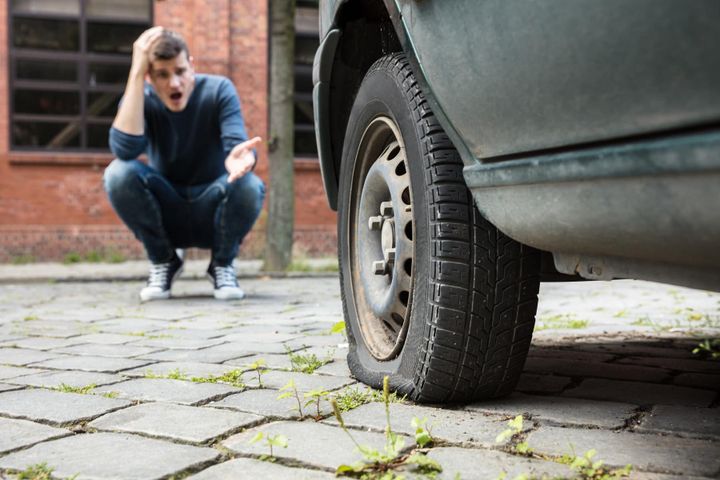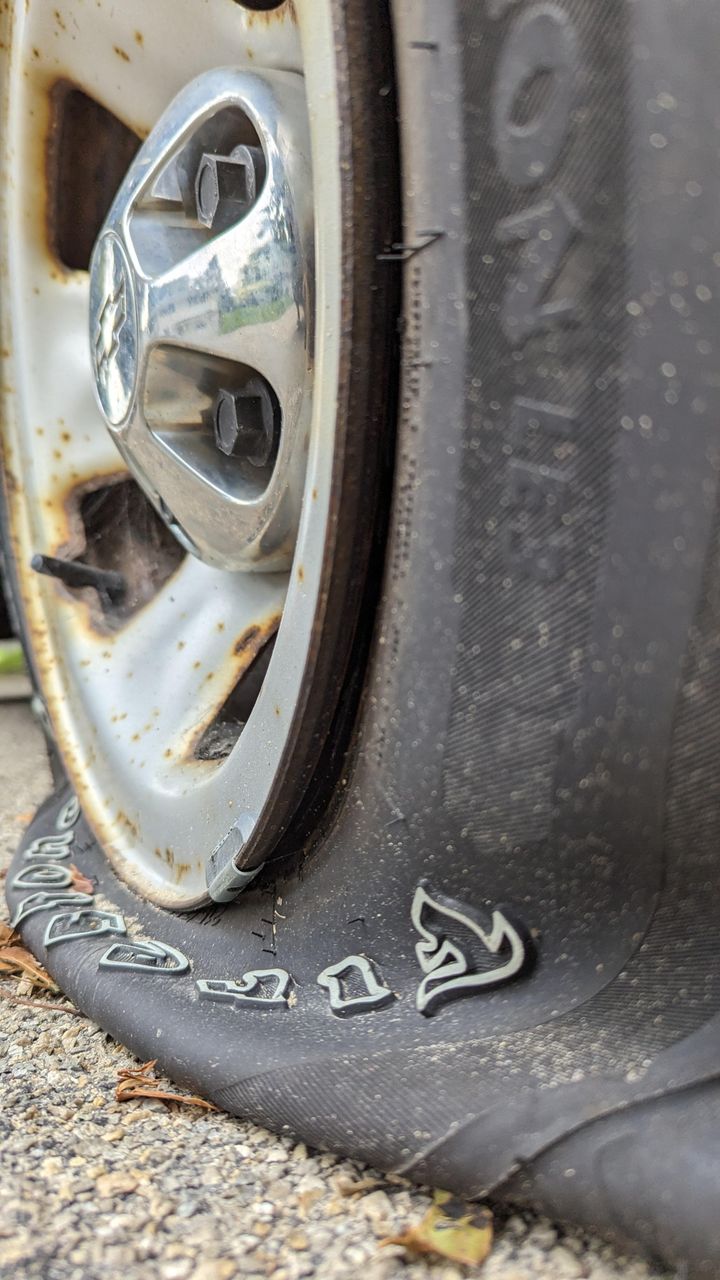


Flat tires are an inevitable occurrence for most drivers, and how you handle them can significantly impact the safety and longevity of your vehicle's components. While it may seem harmless to leave a car sitting on a flat tire for a short period, prolonged neglect can lead to costly repairs and potential safety hazards. This article delves into the intricate details of how long a car can sit on a flat tire before sustaining damage, exploring the various components at risk, recommended timeframes for addressing a flat, and alternatives available to mitigate potential issues.

Flat tires are a common occurrence on the road, and how you handle them can have far-reaching consequences. Prolonged neglect of a flat tire can lead to costly repairs and potential safety hazards. This article explores the details of how long a car can sit on a flat tire before sustaining damage, the components at risk, recommended timeframes for addressing a flat, and alternatives to mitigate potential issues.
Tires are designed to support the weight of a vehicle while in motion, but when a car sits on a flat tire, the weight distribution changes, leading to potential damage. The following table outlines the types of tire damage that can occur:
| Damage Type | Description |
|---|---|
| Sidewall Damage and Delamination | The excessive flexing and stress on the sidewall can cause the internal layers to separate or delaminate, compromising the tire's structural integrity. |
| Flat Spots | Rigid areas where the tire has been compressed against the ground, causing vibrations and uneven wear when driving. |
| Tire Deterioration and Dry Rot | Prolonged exposure to sunlight, heat, and environmental factors can accelerate the aging process, leading to dry rot, cracking, and deterioration of the rubber compound. |
When a tire is completely flat, the weight of the vehicle is concentrated on a small area of the tire's sidewall, causing it to bend and flex excessively. This excessive flexing and stress can cause the internal layers of the tire to separate or delaminate, compromising the structural integrity of the tire. The delamination process can occur rapidly or gradually, depending on the severity of the flat and the weight of the vehicle.
If a car sits on a flat tire for an extended period, usually more than a month, flat spots can develop on the tire. These flat spots are rigid areas where the tire has been compressed against the ground, causing vibrations and uneven wear when driving. Even after inflating the tire, these flat spots can create an uncomfortable and potentially unsafe ride, as the tire will not regain its original shape.
Prolonged exposure to sunlight, heat, and environmental factors can accelerate the aging process of the tire, leading to dry rot, cracking, and deterioration of the rubber compound. This can significantly reduce the tire's lifespan and increase the risk of a blowout or sudden failure. The rate of deterioration can vary depending on the tire's age, composition, and environmental conditions.
In addition to tire damage, leaving a car on a flat tire for an extended period can also potentially harm other components of the vehicle, such as the rims and suspension system.
When a tire is completely flat, the rim comes into direct contact with the ground, which it is not designed for. This can cause the rim to bend, warp, or sustain other forms of damage, potentially leading to costly repairs or even the need for a replacement. The extent of the damage can depend on factors such as the weight of the vehicle, the duration of contact with the ground, and the surface conditions.
The weight of the vehicle resting on a flat tire can put additional stress on the suspension components, such as the shocks, struts, and control arms. This stress can lead to premature wear or damage, affecting the vehicle's handling and ride quality. The following table outlines the potential suspension components at risk:
| Component | Potential Damage |
|---|---|
| Shocks | Excessive wear or leakage |
| Struts | Premature failure or damage |
| Control Arms | Bending or excessive wear |

Driving on a tire that has been sitting flat for an extended period can be extremely dangerous, even if the tire appears to hold air after being inflated. The internal damage and potential for a blowout or loss of control increases significantly, putting the driver and others at risk. The following list highlights some of the safety concerns associated with driving on a tire that has been sitting flat:
Increased risk of a blowout
Reduced traction and handling
Potential loss of control
Compromised braking performance
Increased risk of hydroplaning in wet conditions
If you find yourself in a situation where your car has a flat tire and you cannot address it immediately, there are a few alternatives to consider.
If your vehicle is equipped with a spare tire, it's best to replace the flat tire with the spare as soon as possible to avoid any potential damage. Spare tires are designed for temporary use and should be replaced with a new tire as soon as possible. It's important to note that some spare tires, such as compact or "donut" spares, have limitations in terms of speed and distance, so it's crucial to follow the manufacturer's recommendations.
If you cannot replace the tire immediately, consider using jack stands or other supports to lift the affected wheel off the ground, relieving the weight and pressure on the flat tire. This can help prevent further damage until you can properly address the issue. However, it's important to follow proper safety procedures when using jack stands and to ensure the vehicle is securely supported.
Many insurance providers or automotive clubs offer roadside assistance services that can help you change a flat tire or tow your vehicle to a repair facility. This can be a convenient and safe option, especially if you're stranded or lack the necessary tools or expertise to change the tire yourself. Roadside assistance services can provide a temporary solution and help you get your vehicle to a safe location for proper repairs.
While the exact timeframe for potential damage to occur can vary depending on factors like the severity of the flat and the weight of the vehicle, most experts recommend not leaving a car on a flat tire for more than 24 hours. This timeframe minimizes the risk of irreparable tire damage, rim damage, suspension issues, and potential safety concerns.
However, it's important to note that the recommended timeframe is a general guideline, and the actual time before damage occurs can vary. Factors such as the age and condition of the tires, the weight of the vehicle, and the environmental conditions can all influence the rate at which damage occurs.
The following table provides a general guideline for the recommended timeframe based on the severity of the flat:
| Flat Severity | Recommended Timeframe |
|---|---|
| Completely Flat | Address within 24 hours |
| Partially Flat | Address within 48 hours |
| Slow Leak | Address within 72 hours |
It's crucial to address a flat tire as soon as possible, regardless of the severity, to minimize the risk of potential damage and ensure safe driving conditions.
Addressing a flat tire promptly is crucial for ensuring the safety and longevity of your vehicle's components. Leaving a car sitting on a flat tire indefinitely is not recommended, as it can lead to various issues, including tire damage, rim damage, suspension problems, and potential safety hazards. By understanding the implications of leaving a car on a flat tire and taking proactive measures, such as using a spare tire, jack stands, or calling for roadside assistance, you can mitigate the risks and protect your vehicle's integrity. Remember, prevention is always better than costly repairs or compromised safety.
Driving on a flat tire can cause further damage to the tire, rim, and suspension components. It also increases the risk of a blowout, loss of control, and compromised safety.
It is not recommended to leave a car on a flat tire for more than 24 hours, as it can lead to irreparable tire damage, rim damage, and suspension issues.
Spare tires, especially compact or "donut" spares, have limitations in terms of speed and distance. They should be replaced with a new tire as soon as possible.
Flat spots are rigid areas that develop on a tire when a car sits on a flat tire for an extended period, usually more than a month.
Yes, prolonged exposure to sunlight, heat, and environmental factors can accelerate the aging process, leading to dry rot, cracking, and deterioration of the rubber compound.
Shocks, struts, and control arms are suspension components that can be damaged by the additional stress caused by a car sitting on a flat tire.
No, driving on a tire that has been sitting flat for an extended period can be extremely dangerous, even if the tire appears to hold air after being inflated.
Driving on a damaged tire increases the risk of a blowout, reduced traction and handling, potential loss of control, compromised braking performance, and increased risk of hydroplaning in wet conditions.
Yes, using jack stands or other supports to lift the affected wheel off the ground can help prevent further damage until you can properly address the flat tire.
If you cannot change the flat tire immediately, consider using the spare tire, jack stands, or calling for roadside assistance to avoid potential damage and safety concerns.

Sarah isn't your average gearhead. With a double major in Mechanical Engineering and Automotive Technology, she dived straight into the world of car repair. After 15 years of turning wrenches at dealerships and independent shops, Sarah joined MICDOT to share her expertise and passion for making cars run like new. Her in-depth knowledge and knack for explaining complex issues in simple terms make her a valuable asset to our team.









